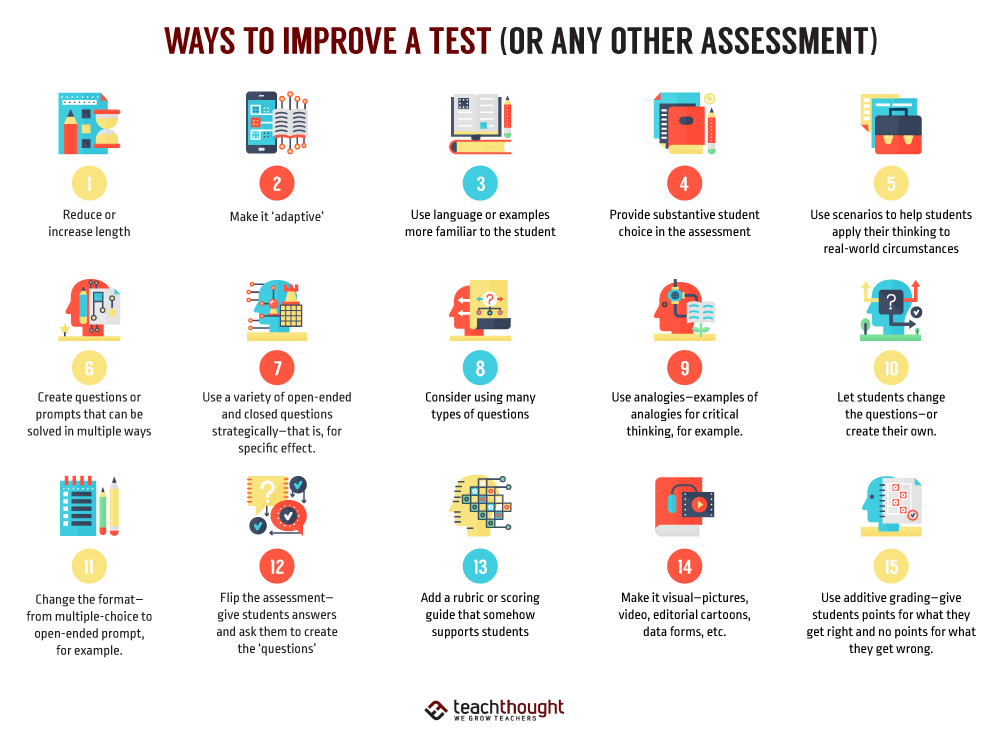
Improve Tests, Quizzes, And Other Assessments With These Tips
by TeachThought Staff
There is often talk about assessment–its forms, frequency, and the integration of gleaned data to revise planned instruction.
Formative versus assessment, rigor, and the evasive nature of understanding are also areas for exploration. But rarely is there discussion about the kinds of things teachers can do–literal actions and concrete strategies–to help streamline the assessment process, and hopefully produce purer results you can trust.
There are countless ways to improve a test–or quiz or any other assessment you give a student. How you improve it depends on what you’re hoping to accomplish with the assessment, your plan to use the data, and where that assessment (as it is) is strong, and where it can be improved.
It might be that an existing standards-based multiple-choice exam is strongly aligned with those standards, the questions are clear, and the answers are accurate but it may simply be too long or given at the wrong time. Or it might benefit from more engaging examples in given passages or questions to more strongly activate student background knowledge.
20 Ways To Improve A Test, Quiz, Or Other Assessment
1. Reduce or increase length
2. Make it ‘adaptive’–using technology, for example. That is, make sure it scales to be accessible to students who might be struggling while also challenging students who may have already mastered the material.
3. Use language or examples more familiar, interesting, amusing, or otherwise more engaging to the student
4. Provide substantive student choice in the assessment–form, items, timing, etc.
5. Use scenarios to help students apply their thinking to real-world circumstances
6. Create questions or prompts that can be solved in multiple ways
7. Use a variety of open-ended and closed questions strategically–that is, for specific effect.
8. Consider using many types of questions
9. Use analogies–examples of analogies for critical thinking, for example.
10. Let students create their own assessment. How well this works depends on the student and content and grade level and type of assessments and so on. But for the right application, the questions or challenges students create and what their responses are can give you valuable data–and after all, isn’t data what you’re looking for?
11. Change the format–from multiple-choice to open-ended prompt, or matching to gamified debate, or essay/short response to part fill-in-the-blank and part multiple-choice, for example.
12. Flip the assessment–give students answers and ask them to create the ‘questions’
13. Add a rubric or scoring guide that somehow supports students–one that clarifies something that otherwise might be confusing and get in the way of assessing what the student actually understands
14. Make it visual–pictures, video, editorial cartoons, data forms, etc.
15. Use additive grading–give students points for what they get right and no points for what they get wrong rather than a percentage correct. This can encourage students to want to ‘earn points’ over time rather than simply ‘pass the test’ and move on. This can also make tests less threatening and more conducive to formative assessment patterns (using data from inform instruction on an ongoing basis).
16. Let the student modify the assessment. This wouldn’t give you data measured against a benchmark but it would give you data of where that student ‘is’ more clearly than simply getting an answer ‘wrong’
17. Gamify it–Challenges, points, levels to be ‘unlocked,’ leveling up of specific skills, etc.
18. Update or improve any source material–reading passages, for example.
19. Repeat it. Let struggling students simply retake it while students who score above a certain percentage change or add questions to challenges to reflect their actual knowledge level (versus simply ‘passing the test).
20. Make it multimodal–conversation, text, concept-mapping, multiple-choice, etc. This takes more work but to ease the burden, you can create templates for multimodal assessments and use them throughout the year.
Another quiz might benefit from better alignment with learning objectives, while another could be improved by using some kind of adaptive learning algorithm that scales to a student’s performance.
Coupled with our 10 Assessments You Can Perform In 90 Seconds Or Less, that’s several dozen simple formative assessment forms and strategies to add to your teacher toolset.
